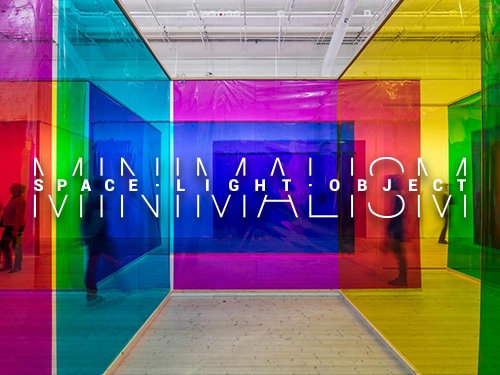

Minimalism: Space. Light. Object.
16 November 2018 to 14 April 2019
The exhibition Minimalism: Space. Light. Object. takes place across the galleries of two museums, ArtScience Museum and National Gallery Singapore. It features more than 150 works of art by over 80 artists and 40 composers. Through painting, sculpture, installation, performance and music, the exhibition shows how Minimalism became a turning point in the history of 20th century art.
Advisory 16 (Some Nudity)
Minimalism offers a powerful new way of experiencing art. Rather than referencing the world outside, its simple forms invite us to contemplate what’s physically before us in the present moment.
Minimalism emerged as a major tendency in 1960s New York, but its roots can be traced back to much earlier Asian philosophies and artistic styles. By paring artworks down to their essential elements, Minimalist artists sought to strip away individual expression and artistic decision-making and create a direct encounter between the viewer and the artwork.
The five-month exhibition is the first survey of Minimalist art held in Southeast Asia, and the first major Minimalism exhibition to include artists from this region as part of an expanded global perspective on the movement. At National Gallery Singapore, visitors can trace the development and rich legacies of Minimalist art and ideas from the 1950s to the present day. At ArtScience Museum, the exhibition delves into Asian philosophy exploring the impact these ideas had on artists across the world.
The galleries of Level 3 and Basement 2 at ArtScience Museum reflect on the profound simplicity and stillness inherent in Eastern interpretations of Minimalism, whilst embodying the bare, angular starkness that made it such a vital force in the 1960s in the West. Many of the artworks in the exhibition meditate on notions of the Void — an idea that resonates with both Minimalism and science. Sound also forms an important part of the exhibition, acting as an auditory counterpoint to the visual explorations of Minimalism presented within the galleries.
Overall, the exhibition seeks to express the idea, often attributed to Albert Einstein that “everything should be made as simple as possible, but not simpler”.
Artist & Composers
Artists presented at ArtScience Museum
Anish Kapoor (India), Austin Forbord and Shelley Trott (directors), Carmen Herrera (Cuba), Charwei Tsai (Taiwan), Chen Shiau-Peng (Pescadores Island), Donald Judd (USA), Frederik De Wilde (Belgium), Gerard Byrne (Republic of Ireland), Jeppe Hein (Denmark), Jeremy Sharma (Singapore), Joan Jonas (USA), Mary Miss (USA), Mona Hatoum (Lebanon), Morgan Wong (Hong Kong), Olafur Eliasson (Denmark), Richard Long (UK), Simone Forti (Italy), Song Dong (China), Tan Ping (China), Tawatchai Puntusawasdi (Thailand), teamLab (Japan), Wang Jian (China), Yvonne Rainer (USA), Zhang Yu (China), Zhou Hong Bin (China)
Composers presented at ArtScience Museum
Adeline Wong (Malaysia), alva noto (Germany), Anton Webern (Austria), Arnold Schönberg (Austria), Arvo Pärt (Estonia), Béla Bartók (Romania), Caterina Barbieri (Italy), Charlemagne Palestine (USA), Colin McPhee (Canada), Daphne Oram (UK), Éliane Radigue (France), Else Marie Pade (Denmark), Erik Satie (France), FM3 (China), Francisco López (Spain), George Antheil (USA), Hildegard Westercamp (Germany), Hiroshi Yoshimura (Japan), Jana Winderen (Norway), Jo Kondo (Japan), Johanna M. Beyer (Germany), John Adams (USA), John Cage (USA), La Monte Young (USA), Maryanne Amacher (USA), Pauline Oliveros (USA), Philip Glass (USA), Pierre Henry & Pierre Scheaffer (France), Ryoji Ikeda (Japan), Ryuichi Sakamoto (Japan), Steve Reich (USA), Terry Riley (USA), Tetsu Inoue (Japan), Thomas Köner (Germany), Tony Conrad (USA), Unsuk Chin (Korea), Yves Klein (France)
